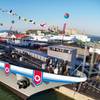The U.S National Ice Center (USNIC) in coordination with the Office of Naval Research, Office of the Oceanographer of the Navy, the Danish Joint Arctic Command, Environmental and Climate Change Canada and University of Washington deployed buoys into the Arctic Ocean during a joint mission.
The joint mission was conducted to collect weather and oceanographic data to enhance forecasting and environmental models thereby reducing operational risk for assets in the Arctic.
"Polar lows are like hurricanes of the north and the data collected from these buoys will help us with numerical weather prediction, which will help to keep our and our partner forces safe," said Cmdr. Ruth Lane, Commanding Officer, U.S. National Ice Center.
"For example, when Hurricane Irma was approaching the Caribbean Islands. Once the hurricane was within the range of NOAA's Hurricane Hunter aircraft they flew out and dropped buoys through the hurricane. The surge of observations returned improved the track and intensity models. Forecast accuracy improves tremendously from the surge of local observations. Our goal with these Arctic buoys is a similar return on investment," Ruth Lane added.
The ice-hardened buoys, known as Air Expendable Ice Beacons (AXIB), were deployed from a Royal Danish Airforce C-130 aircraft deploying out of Thule Air Base in Greenland. "Pilots supporting the Danish Joint Arctic Command were conducting training flights in the high Arctic, so we were able to leverage these flights to deploy the buoys for the first time out of a Danish aircraft and only the second time over the North Pole," said Lt. Emily Motz, U.S. National Ice Center, coordinator for the Arctic Buoy Program. "The buoys will provide data for 3-5 years providing operational and scientific community's access to the in-situ observations available to all forecasters and researchers through the International Arctic Buoy Program (IABP)."
USNIC, in partnership with University of Washington, is responsible for management and coordination of the U.S Interagency Arctic Buoy Program (USIABP) and represents other U.S agencies including International Arctic Research Center, NASA, the National Science Foundation, Naval Oceanographic Office and Office of Naval Research. The IABP is a conglomeration of global participants that maintain a network of drifting buoys in the Arctic Ocean. The buoy effort also provides important data to the Office of Naval Research Seasonal Ice Zone Reconnaissance Surveys (SIZRS) program, which is the core of their Arctic and Global Prediction Program.
"Unique opportunities like this are a result of relationships built under the International Cooperative Engagement Program for Polar Research," said Ninette Sadusky, senior science policy advisor, Office of the Oceanographer of the Navy. "ICE-PPR is a multi-national effort led by the Office of the Senior National Representative within the Office of the Chief of Naval Operations (OPNAV N94). It's important that we continue to foster partnerships and ongoing missions like the buoy program continue to thrive."














